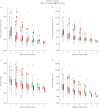Airway-artery quantitative assessment on chest computed tomography in paediatric primary ciliary dyskinesia
- PMID: 32964004
- PMCID: PMC7487358
- DOI: 10.1183/23120541.00210-2019
Airway-artery quantitative assessment on chest computed tomography in paediatric primary ciliary dyskinesia
Abstract
Chest computed tomography (CT) is the gold standard for detecting structural abnormalities in patients with primary ciliary dyskinesia (PCD) such as bronchiectasis, bronchial wall thickening and mucus plugging. There are no studies on quantitative assessment of airway and artery abnormalities in children with PCD. The objectives of the present study were to quantify airway and artery dimensions on chest CT in a cohort of children with PCD and compare these with control children to analyse the influence of covariates on airway and artery dimensions. Chest CTs of 13 children with PCD (14 CT scans) and 12 control children were collected retrospectively. The bronchial tree was segmented semi-automatically and reconstructed in a three-dimensional view. All visible airway-artery (AA) pairs were measured perpendicular to the airway centre line, annotating per branch inner and outer airway and adjacent artery diameter and computing inner airway diameter/artery ratio (AinA ratio), outer airway diameter/artery ratio (AoutA ratio), wall thickness (WT), WT/outer airway diameter ratio (Awt ratio) and WT/artery ratio. In the children with PCD (38.5% male, mean age 13.5 years, range 9.8-15.3) 1526 AA pairs were measured versus 1516 in controls (58.3% male, mean age 13.5 years, range 8-14.8). AinA ratio and AoutA ratio were significantly higher in children with PCD than in control children (both p<0.001). Awt ratio was significantly higher in control children than in children with PCD (p<0.001). Our study showed that in children with PCD airways are more dilated than in controls and do not show airway wall thickening.
Copyright ©ERS 2020.
Conflict of interest statement
Conflict of interest: V. Ferraro has nothing to disclose. Conflict of interest: E-R. Andrinopoulou has nothing to disclose. Conflict of interest: A.M.M. Sijbring has nothing to disclose. Conflict of interest: E.G. Haarman has nothing to disclose. Conflict of interest: H.A.W.M. Tiddens reports unconditional research grants outside the submitted work from Roche, Novartis, CFF, Vertex, Chiesi, Vectura and Gilead; he has participated in the last 5 years in expert panels for Vertex and Gilead. In addition, Dr Tiddens has a patent licensed for the PRAGMA-CF scoring system. He heads the Erasmus MC–Sophia Children's Hospital core laboratory Lung Analysis. FLUIDDA has developed computational fluid dynamic modelling based on chest CTs obtained from Erasmus MC–Sophia for which royalties are received by Sophia Research BV. All financial aspects for the grants are handled by Sophia Research BV. Conflict of interest: M.W.H. Pijnenburg has nothing to disclose.
Figures






References
-
- Lucas JS, Chetcuti P, Copeland F, et al. . Overcoming challenges in the management of primary ciliary dyskinesia: the UK model. Paediatr Respir Rev 2014; 15: 142–145. - PubMed
LinkOut - more resources
Full Text Sources
Research Materials
